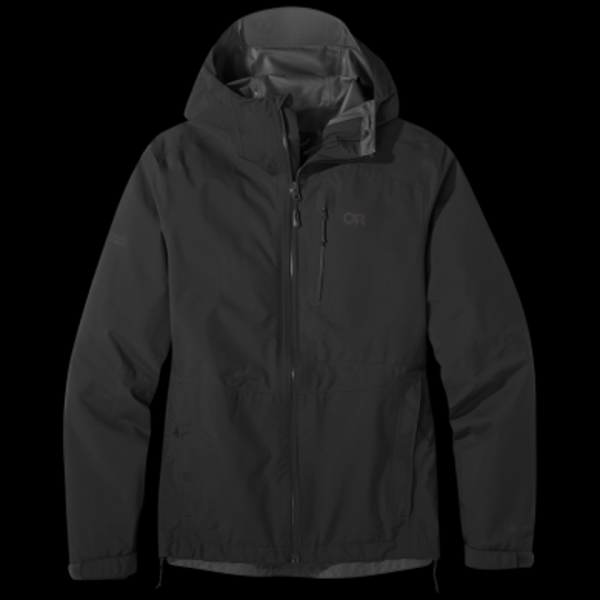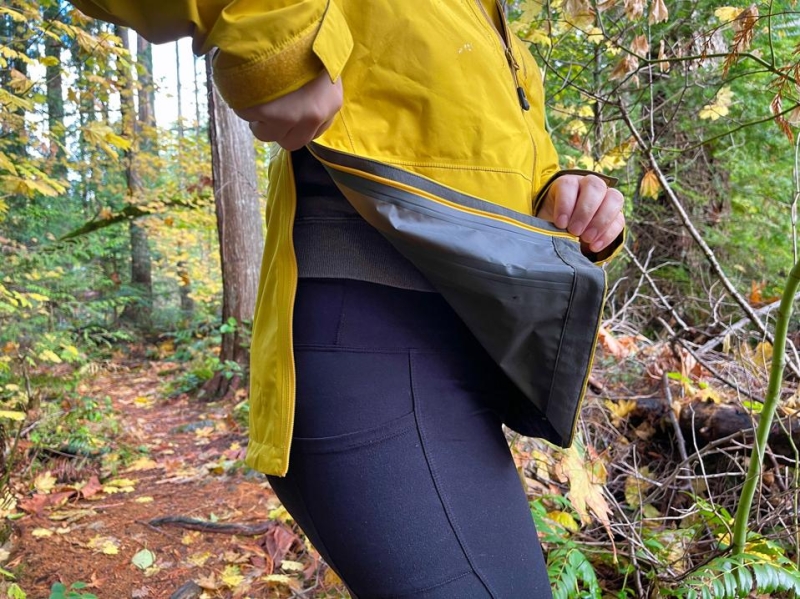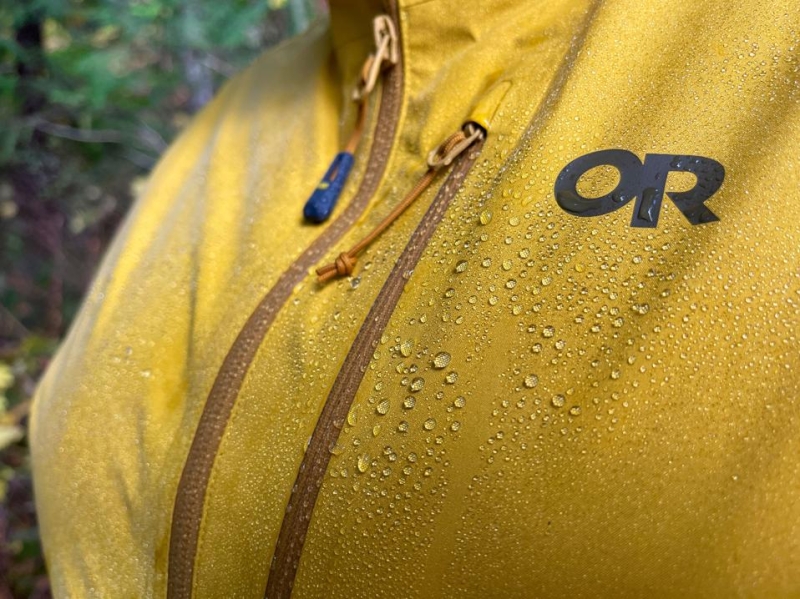
Outdoor Research Women’s Aspire II Gore-Tex Jacket
Style: Women’s Aspire II | Women’s Aspire II Plus Size | Men’s Foray II | Sizes: Women’s XS to 4X | Men’s S to XXXL | Colors: 8 | Fabric: 100% polyester | Waterproofing: Two-layer Gore-Tex with Paclite technology | Sustainability: Bluesign-approved Gore-Tex | Warranty: Limited lifetime
Best For:
- Everyday use, outdoor activities, traveling and commuting
- People who want to own one versatile rain jacket
- Most climates and seasons
Skip If:
- You need an insulated rain jacket for colder climates
Outdoor Research Aspire II Features
Waterproofness and breathability are often at odds in a rain jacket, but the Aspire II proved to have both. It’s constructed with two-layer Gore-Tex Paclite, a lightweight and breathable fabric membrane that will keep you dry in almost any wet-weather situation. I wore the Aspire II during the wettest Pacific Northwest months of the year and stayed dry during every outing, from drizzles to heavy downpours, and the jacket also passed the test when I wore it in the shower to assess its water resistance. Most droplets beaded off the jacket—there were very few instances when moisture soaked into the fabric, but even then, it didn’t cross the waterproof membrane.
Here’s what I especially liked: The Aspire II’s waterproofness doesn’t come at the expense of breathability. A lot of rain jackets do a fine job of keeping moisture from penetrating through, but they fail to let vapor from your body escape, which causes the jacket to feel clammy (like heavy fisherman-style rain slickers of the past). The Gore-Tex membrane on the Aspire II jacket allows sweat to escape while still blocking out water. Even on a brisk hourlong walk in the sunshine and a 15-minute session on my indoor rower, I didn’t feel overly hot. Though in colder temperatures, you’ll need to add a thicker layer underneath to keep warm.
This do-it-all shell is heavy on features that don’t feel overbuilt for everyday use. For example, the underarm zippers allow you to zip both ways to get ventilation where you need it. And if you unzip the side zippers completely, you can wear the jacket poncho-style over a backpack, which lets you take cover quickly if you get caught in a sudden rain shower. The two-way front zipper is reinforced with a storm flap to keep water out, and unzipping from the bottom up increases airflow and movement in the midsection. The Aspire II also has an adjustable hood that didn’t impede my peripheral vision when turning my head from side to side.

The underarm zippers can be unzipped completely, allowing you to wear the jacket poncho-style over a backpack.
The fabric isn’t as robust and hard-wearing as other hard-shell rain jackets, but the Aspire II isn’t paper-thin either, so it can be layered up or down. The jacket’s texture is noticeably supple and soft to the touch, with a brushed velvety finish. It also moves with the body and doesn’t make a swishing sound when walking. Soft microfleece against the chin adds a cozy touch, and the adjustable cuffs and hem help seal out water. The Aspire II can also be rolled into the hood or stuffed into the hand pocket to pack down to roughly the size of a 16-ounce water bottle, making it easy to fit in luggage or a tote bag.
The Outdoor Research line has the most inclusive size range of the 10 jackets I tested (the Women’s Aspire II comes in XS to 4X and the Men’s Foray II in S to XXXL), and there are plenty of color options in both muted and bright hues. I tested the not-too-bright yellow Larch color, which pops against an outdoor backdrop, and my partner wore the two-tone Nimbus and Naval Blue, which he liked because it paired with everything in his closet.
I laundered the jacket once, putting it through a standard wash cycle in my front-loading machine and drying it on low heat. There were no changes to the water repellency or the seams, shape or color of the jacket. The Aspire II is also backed by Outdoor Research’s Infinite Guarantee, which ensures it will hold up for the typical lifetime of the garment but doesn’t cover normal wear and tear or user-created damage. Outdoor Research will also send Tenacious Tape repair patches if you’re in the U.S. or Canada to keep your jacket lasting as long as possible.
How Does The Outdoor Research Aspire II Compare?
The Helly Hansen Moss Raincoat was awarded the best value rain jacket in my in-depth rain jacket review. At about half the price of the Aspire II, the Moss is a rubbery waterproof rain jacket that will keep you just as dry (and for longer periods), though it isn’t as breathable, comfortable to wear or travel-friendly. And the classic fisherman’s style of the Moss might not be as universally appealing as the Aspire II. Still, for those who need a raincoat for sustained wet conditions, the Moss hangs a little lower, and the slick polyurethane fabric is practically impenetrable.
I also tested the Outdoor Research Women’s Aspire Trench ($249), a more extended mid-thigh version of the Aspire II. The trench forgoes some of the performance features, most notably the side zippers, in favor of a more stylish silhouette for casual everyday use. The shaped hem features side snaps for added mobility, and the butt coverage is essential if you need to sit down on wet surfaces. If you’re looking for a lightweight waterproof trench, the longer Aspire is just as packable, comfortable and waterproof as the shorter model.
How I Tested The Best Rain Jackets
The Aspire II rain jacket was one of the 10 contenders I tested as part of my best rain jackets review. I wore it during the height of the Pacific Northwest rainy season, walking my dog, running errands around town, playing with my son outdoors and on a rainy afternoon hike. I laundered the jacket once using my front-loading washing machine and dryer, tested the waterproofness in my home shower and assessed breathability during a 15-minute rowing session on my indoor water rower. I also used a water dropper and spray bottle to evaluate moisture beading closely and inspected the jacket’s seams for any signs of leakage. As I was testing, I paid close attention to water resistance, comfort, breathability, durability and overall versatility.
My Expertise
I’m a journalist who has covered outdoor gear and apparel for almost a decade. I’ve written about rainwear for brands like REI and as a gear columnist at Outside online. In that time, I’ve tested dozens of water-resistant jackets and spoken with multiple experts on the topic. Based in the Pacific Northwest, I get about 180 rain days a year, so I’m almost always wearing something waterproof.
For this story, I also interviewed three experts, including Fashion Institute of Technology (FIT) assistant professor Preeti Arya, who teaches courses on finishes, fabric development and performance textiles. I talked to Sarah Rutson, former vice president of global buying at Net-a-Porter, and Sara Ellis, a product specialist in the fabrics division at Gore-Tex. I also had a chance to virtually tour Gore-Tex’s testing labs, including its rain room, environmental chamber and biophysics lab.
How Does Gore-Tex Work?
The simplest way to think about Gore-Tex is as a waterproof and breathable fabric membrane (although, in reality, it’s a much more complex system). The membrane is typically sandwiched between an outer face fabric and an inner liner. For it to be both waterproof and breathable, it needs to stop water droplets from making their way through the membrane while at the same time letting water vapor, aka sweat, escape. The flexible membrane consists of microscopic pores that are smaller than the size of a water droplet but larger than a water molecule, enabling moisture to make its way out while keeping water from getting in.
Additionally, Gore-Tex gear is treated with a durable water repellent (DWR) to help water bead up and roll off the jacket before it can soak in, making the system more effective at transferring hot air out.

Gore-Tex gear is treated with a durable water repellent (DWR) to help water bead up and roll off the jacket before it can soak in.
Is Gore-Tex Worth It?
Whether you need a Gore-Tex jacket comes down to your lifestyle, your budget and the conditions you’ll be wearing the jacket in. Some brands have proprietary waterproofing systems that perform just as well, especially for what most people need, but Gore-Tex may be worth the splurge if you’re looking for a reliable waterproof, breathable and robust jacket, especially for high-output activities like outdoor sports. If you need a rain jacket for running from the car to the store or as an emergency item you’ll hardly ever use, going all out on a Gore-Tex jacket might not make sense. You may be able to get by with a much less expensive waterproof or even water-resistant jacket. If you do go for Gore-Tex, make sure to care for it properly to ensure it remains effective.
How To Care For Gore-Tex
Some people are wary of laundering their Gore-Tex gear because they think it will damage the membrane or compromise the waterproofness. In fact, it needs regular laundering to ensure it remains waterproof and breathable because contaminants like dirt and oil can clog up the system. “We highly encourage people to wash and dry their jackets,” says Sara Ellis, a product specialist with the brand, who recommends a typical wash cycle of about 100 degrees. “Zip all the zippers up, and use liquid detergent. We don’t recommend powder detergent or fabric softeners.” Rinsing twice is preferred to make sure there’s no residue left behind. Tossing it in the dryer afterward will help rejuvenate some of the treatments within the jacket, like the DWR finish. For more tips to keep your jacket long-lasting, REI has a great resource on how to care for Gore-Tex rainwear.


